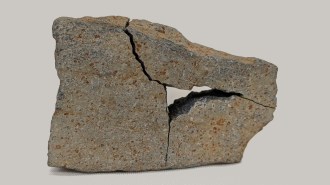Turbulent ocean could explain Europa’s chaotic ice

A simulation (left) of Europa’s global ocean dynamics shows warmer (red) and cooler (blue) temperatures where more heat is delivered to the ice shell near the equator. That uneven heating could explain the nonuniform pattern of ice on the moon's surface (right).
Model image: J. Wicht; Europa: Univ. of Arizona, JPL/NASA







